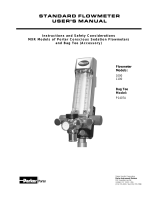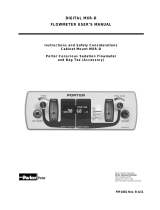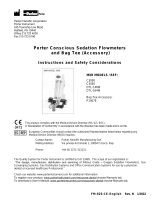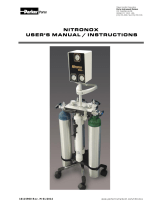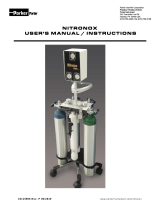Page is loading ...

FM-118 G 7/21

2
Table of Contents
Warnings and Precautions .................................................................................................. 3
Installation Requirements .................................................................................................... 4
NFPA Requirements ........................................................................................................... 4
Plumber’s Instructions .........................................................................................................5 – 8
Installation ........................................................................................................................... 5
Nitrogen Test Fixture ................................................................................................ 5
Test for Crossed Lines .............................................................................................. 6
Nitrogen Test – Test System for Leaks ..................................................................... 7
Manifold System Leak Test Diagram ........................................................................ 8
Electrician’s Instructions ..................................................................................................... 9
Wall and Desk Sentinel Installation ........................................................................... 9
Carpenter’s Instructions .................................................................................................... 10
Tank Room ............................................................................................................. 10
Dealer’s Instructions ........................................................................................................11 – 12
Verification of Installation ................................................................................................ 11
Test for Crossed Lines ............................................................................................ 11
Check Sentinel ........................................................................................................12
Drawing 1 – Installation Diagram ....................................................................................... 13
Drawing 2 – Tank Room and System Diagram .................................................................. 14
Drawing 3 – Wall and Desk Wiring Illustration ................................................................... 15
Warranty, Orders and Return Policies .............................................................................. 16

3
Please read this manual carefully before operating the Sentinel Manifold System.
Remove product from package and inspect for damage. If there is any damage, do not use (Contact
your dealer.). Complete Warranty Card and return to Porter.
These warnings and precautions are to help you to understand how to safely operate or troubleshoot the
Porter Sentinel Manifold System. A WARNING alerts you to a possible hazard to people. A CAUTION
alerts you to the possibility of equipment damage.
WARNING
Dental workers are exposed to N2O during
administration of N2O / O2 conscious sedation
analgesia. NIOSH has recommended that
exposures should be minimized. Contact NIOSH
(1-800-35-NIOSH) to receive NIOSH Publications
on Control of Nitrous Oxide in Dental Operatories.
Exposure can be minimized by effective controls.
National Institute for Occupational Safety and
Health (NIOSH) publications state that controls,
including System Maintenance, Ventilation and
Work Practices can effectively reduce N2O
concentrations in dental operations. Your Porter
Scavenger System is an important part of the
system of controls.
Porter Sentinel System Manifolds, Zone Valves
and Outlet Stations utilize the cross +
protection system. The copper tubing is
diameter indexed; 3/8” O.D. for Nitrous Oxide and
1/2” O.D. for Oxygen. The cross + protection
system is designed to prevent misconnection of
Oxygen and Nitrous Oxide piping.
DO NOT ATTEMPT TO CHANGE THE
DIAMETERS! ! Tampering with the cross +
protection system constitutes acceptance of
liability by the installer. For your own protection,
as well as that of the Doctor and the patients, use
3/8” O.D. tubing for all Nitrous Oxide lines and
1/2” O.D. tubing for all Oxygen Lines.
If you are using Outlet Stations of another
manufacturer, which have 3/8” O.D. tubing on
both inlets, use a reducer at the Outlet Station,
NOT at the Porter Manifold. This will enable you
to utilize the cross + protection system to that
point.
The Porter Manifold has safety protection
provided in the equipment. If the equipment is
tampered with or used in a manner not specified
in this manual the safety protection provided by
the equipment might be impaired.
CAUTIONS
Use no Oil: Never use oils, greases, organic
lubricants or any combustible materials on or near
this product.
The Porter Manifold controls both Oxygen (O2) and
Nitrous Oxide (N2O). Both gases could be present
in an over pressure event that requires the safety
relief valve to function.
Static Damage Hazard: Computer and other
electronic components can be permanently
damaged by static electric discharge. Use caution
when working with the molded manifold cover off.
Power Outage: During any power outage,
remember to turn OFF the flowmeter and manually
turn OFF the tank valves. When the power is
restored, the Sentinel will come back to its status
prior to the power outage. If gas was flowing when
the power went out, gas will be flowing when the
power is restored.
Safe handling of gas cylinders is important. Please
see your gas supplier or refer to training aids such
as the 7 Minute Trainer from Business and Legal
Reports Inc.

INSTALLATION REQUIREMENTS
4
To assure safe operation and conformation to local fire codes, all Porter Manifold Systems are
designed to be used with sedation delivery systems mounted inside walls and they meet or exceed
the guidelines established by the National Fire Protection Association for Nonflammable Medical Gas
Systems, NFPA 99. Copies of NFPA 99 or portions thereof may be obtained by writing to:
National Fire Protection Association
Batterymarch Park
Quincy, MA 02269-9904
Or call: 1-800-344-3555
NFPA REQUIREMENTS
If the installation is in a single treatment facility, the following requirements apply:
1. No more than 3000 cubic feet of gas in the tank room.
2. Gas stored in a separate cabinet or room with a lock on the door.
3. At least 72 square inches of vent area in cabinet or room.
4. A separate regulator for each cylinder of gas.
5. A pressure relief valve set at 75 PSIG.
6. A check valve downstream of the regulator.
7. Line pressure gages for each gas.
8. Type K or L, pre-cleaned, degreased, capped hard copper tubing ONLY.
9. All flexible tubing tested to 1000 PSIG.
10. Flexible tubing must NOT go through wall or partition.
11. System must be tested for leaks with dry Nitrogen for 24 hours at 60 PSIG.
12. Line pressure set at 50 – 55 PSIG.
13. All joints must use copper-phosphorus brazing filler alloy (BcuP series) with at least
1000°F melting point. DO NOT USE FLUX!
14. An audible and visual alarm, set at 40 PSIG low, and 60 PSIG high, must be in a constantly
monitored area.
15. A remote shut-off must be used if gases are stored in a remote area, ie: outside, in the
basement, etc.
16. Outlet station internal valves must NOT be interchangeable.

PLUMBER’S INSTRUCTIONS
5
1. Install Outlet Stations in designated
locations.
See Outlet Station Installation Instructions.
2. Install Manifold in tank room. Bottom
edge is 5 feet from floor.
(See template FM-188 provided with
Manifold.)
3. Run Oxygen and Nitrous Oxide
piping.
a) Use type K or L, pre-cleaned,
degreased, capped copper tubing only.
b) Use 1/2” O.D. tubing for Oxygen lines.
c) Use 3/8” O.D. tubing for Nitrous Oxide
lines.
d) Flow Nitrogen through lines while
soldering. This will prevent oxidation from
contaminating the line. Use Porter
Nitrogen Test fixture.
CAUTION: Use medical grade dry
Nitrogen only. See Text Fixture
instructions.
e) Solder all joints. Solder must have a
melting point of at least 1000°F. Use
silver solder or similar brazing alloy. DO
NOT USE CORROSIVE FLUX! USE
FLUX SPARINGLY! Do NOT USE flare,
compression or pipe fittings.
f) Purge system before attaching Manifold.
g) DO NOT USE oil or grease.
h) Mark pipelines with gas name at least
every 20 feet. Twenty labels are provided
by Porter with Manifold.
i) When pipelines are concealed in a
combustible wall, cover with conduit to
protect from accidental puncture. (See tank
room drawing.)
When Outlet Stations of another
manufacturer are used, reduce size of
Oxygen line at the Outlet Station – use 2
sizes of pipe for Oxygen and Nitrous
Oxide lines to avoid crossed lines.
4. Porter Nitrogen Test Fixture (not supplied)
a) After spotting outlet station in proper
locations (see Porter Installation
Instructions), connect hoses to test fixture.
b) Attach test fixture to Nitrogen tank.
CAUTION: Use medical grade dry
Nitrogen only.
c) Remove dust cover from Outlet Station
and connect hose to station.
d) Set test fixture to “solder” position.
e) Open tank slowly. The “solder”
position allows very low flows of Nitrogen
through the pipeline to prevent oxidation
inside the line. The “Purge” position flows
a high volume to remove any foreign
material before attaching the manifold.
f) After soldering and purging the lines,
pressurize the system to 150 PSIG to leak
test. Check all joints for leaks. Do not use
soapy water – soap contains grease.
g) If no leaks are detected, disconnect the
test fixture from the system, attach
manifold and pressure test the system for
24 hours at 60 PSIG per NFPA 99.
Contact the dental dealer or Porter with
further questions.

PLUMBER’S INSTRUCTIONS
6
TEST FOR CROSSED LINES
WARNING: New or Modified Installations
Assure That Lines Are Not Crossed!
Do not allow crossed lines to defeat the safety features of the dental flowmeter and / or
central gas supply manifold systems. Crossed lines will create a dangerous and
hazardous condition where 100% nitrous oxide will be delivered through the Oxygen
dental flowmeter tube and subsequently to the patient. In addition, the resuscitator
quick connect would deliver 100% Nitrous Oxide to an Oxygen demand valve.
Although two sizes of tubing were used, for your own protection as well as the Doctor and Patients,
test the system for crossed lines as outlined below. The purpose of this test is to confirm that Oxygen
gas is flowing through the Oxygen gas pipeline and Nitrous Oxide gas is flowing through the Nitrous
Oxide pipelines. Doctor and / or dental dealer should witness this test. Do Not Assume The
System Has Been Tested.
1. Use quick connect hoses into Outlet Stations (without machine attached) to bleed Nitrogen out of
system.
2. Connect Oxygen and Nitrous Oxide tanks.
a) Use a regulator for each tank.
b) Chain tanks to wall.
3. Turn on Oxygen pressure ONLY by opening both Oxygen tank regulator.
a) Make sure Nitrous Oxide line pressure reads 0 PSIG on manifold gage.
b) Oxygen line pressure will read 50 PSIG on manifold gage.
4. Insert quick connect hoses in each Outlet Station.
a) Quick connect inserts simultaneously into both Oxygen and Nitrous Oxide outlets.
b) Pressure should be on Oxygen ONLY. Hear and feel flow coming from the Green Hose.
WARNING: If pressure and flow is detected coming from the Nitrous Oxide line
ONLY (Blue Hose), there are crossed lines. This is a dangerous and
hazardous condition and it must be fixed immediately.
5. When the system passes the crossed line test, remove the quick connect and the Oxygen flow
and pressure will be checked by the Outlet Station and 50 PSIG will be trapped in the tubing.
6. Turn off Oxygen at the tank regulator.
a) Bleed Oxygen pressure by inserting quick connect hoses into Outlet Station.
b) Make sure Oxygen line pressure reads 0 PSIG on manifold gage.
7. Turn on Nitrous Oxide pressure ONLY by opening Nitrous Oxide tank regulator.
a) Nitrous Oxide line pressure will read 50 PSIG on manifold gage.

PLUMBER’S INSTRUCTIONS
7
8. Insert quick connect hoses in each Outlet Station.
a) Pressure should be on Nitrous Oxide ONLY. Hear and feel flow coming from the Blue Hose.
WARNING: If pressure and flow is detected coming from the Oxygen line
ONLY (Green Hose), there are crossed lines. This is a dangerous and
hazardous condition and it must be fixed immediately.
9. When the system passes the crossed line test, remove the quick connect and the Nitrous Oxide
flow and pressure will be checked by the Outlet Station and 50 PSIG will be trapped in the tubing.
10. Turn off Nitrous Oxide at the tank regulator.
11. Bleed Nitrous Oxide pressure by inserting quick connect hoses into Outlet Station.
Nitrogen Pressure Test - Test System for Leaks
a) Use Porter Nitrogen Test Fixture (Stock Number B-2065-000) (not supplied).
b) Use medical grade dry Nitrogen.
c) Test with Manifold in place and Outlet Stations assembled.
d) Fill system (both sides) to 60 PSIG.
e) Disconnect Nitrogen tank and fittings.
f) System should hold pressure for 24 hours (allow ±5 PSIG for temperature differences). If
system does not hold pressure, test for leaks at each joint. Repair all leaks and retest. Do not
use soapy water – soap contains grease.
g) After completion of 60 PSIG leak test, bleed system completely. Remove the plugs on the
pressure relief valves. The relief valves supplied on the Porter 3222 Manifold are designed with
internal ¼ NPT connections that allow the user to connect piping to vent the relief valve flow to the
outside if desired.
h) Remove pipe plugs from elbows in the blue and green manifolds. Install the Porter ASME
relief valve assembly into the proper manifold. The assemblies are supplied with pipe tape on
threads. The blue labeled N2O relief valve assembly in the blue manifold block and the green
labeled O2 relief valve assembly into the green manifold block. Tighten each assembly into the
appropriate elbow.
i) Pressurize the system to 50 PSIG only and check the ASME relief valve connections for leaks
using Snoop, LeakTec or soapy water. If leaks are found tighten the connections and check
again.
j) After system is leak tight, bleed system completely.

PLUMBER’S INSTRUCTIONS
8
MANIFOLD SYSTEM LEAK TEST
B-2065-000
NITROGEN TEST
FIXTURE
Pressure Test System for:
24 hours at 60 PSIG per
NFPA 99C Section 5.3.12.23
thru 5.3.12.2.7.4
Function Test Manifold for
tank changeover operation.
Test: 60 PSIG Dry Nitrogen
Leak Test

ELECTRICIAN’S INSTRUCTIONS
9
Wall Sentinel Installation Instructions
1. Cut out opening in wall – 5 7/8” W. x 3 1/4”H.
2. Make (4) points for molly fasteners to be secured using Sentinel Housing as a
template.
3. Secure molly fasteners in wall.
4. Screw tight to housing terminal strip (+) and (-) Low Voltage DC power input leads
from remote mounted transformer.
5. Connect 5775 Sentinel Cable at entry hole on top of housing.
6. Fasten housing in wall with flat head molly screws.
7. Peel of dust cover, and connect Ribbon Cable to 10-pin connector on back of front
plate.
8. Press front plate into place.
9. Plug transformer to AC outlet.
10. Check for operation.
Desk Model Sentinel
1. Install Modular Cable Connection Box at appropriate Sentinel location.
2. Run cable from Modular Cable Connection Box to Manifold.
3. Connect cable to Manifold (see wiring illustration).
4. Connect cable to rear of stainless steel connector plate.
5. Install stainless steel plate to Connection Box.
6. Connect cable from Desk Sentinel to wall plate.
7. Plug transformer from Desk Sentinel to AC outlet.
8. Check for operation.
SEE WIRING DIAGRAM

CARPENTER’S INSTRUCTIONS
10
Tank Room
1. Must be in a separate room or cabinet.
2. A dry wall stud wall will suffice.
3. Door should lock.
4. Room should be vented (72 square inch minimum). A vent in the door will suffice.
5. Attach tank restrainers with lag screws. Install 40” from the floor.
6. Tank Room Instructions (LB-315) and Caution for Non-flammable Medical Gases in Use
(LB-612) are posted.
DO NOT USE TANK ROOM FOR
COMPRESSORS OR
OTHER EQUIPMENT
DO NOT USE TANK ROOM
FOR
STORAGE OF
FLAMMABLE MATERIAL

DEALERS’S INSTRUCTIONS
11
1. Verify that the system has been tested for leaks.
2. Install Wall Mounts or Cabinet Mounts in appropriate locations.
3. Install Cover Plates on Outlet Stations.
4. Install flowmeter heads.
TEST FOR CROSSED LINES
WARNING: New or Modified Installations
Assure That Lines Are Not Crossed!
Do not allow crossed lines to defeat the safety features of the dental flowmeter and / or
central gas supply manifold systems. Crossed lines will create a dangerous and
hazardous condition where 100% Nitrous Oxide will be delivered through the Oxygen
dental flowmeter tube and subsequently to the patient. In addition, the resuscitator
quick connect would deliver 100% Nitrous Oxide to an Oxygen demand valve.
Although two sizes of tubing were used, for your own protection as well as the Doctor and Patients,
test the system for crossed lines as outlined below. The purpose of this test is to confirm that Oxygen
gas is flowing through the Oxygen gas pipeline and Nitrous Oxide gas is flowing through the Nitrous
Oxide pipelines. Doctor and / or dental dealer should witness this test. Do Not Assume The
System Has Been Tested.
1. Use quick connect hoses into Outlet Stations (without machine attached) to bleed Nitrogen out of
system.
2. Connect Oxygen and Nitrous Oxide tanks.
a) Use a regulator for each tank.
b) Chain tanks to wall.
3. Turn on Oxygen pressure ONLY by opening both Oxygen tank regulator.
a) Make sure Nitrous Oxide line pressure reads 0 PSIG on manifold gage.
b) Oxygen line pressure will read 50 PSIG on manifold gage.
4. Insert quick connect hoses in each Outlet Station.
a) Quick connect inserts simultaneously into both Oxygen and Nitrous Oxide outlets.
b )Pressure should be on Oxygen ONLY. Hear and feel flow coming from the Green Hose.
WARNING: If pressure and flow is detected coming from the Nitrous Oxide line
ONLY (Blue Hose), there are crossed lines. This is a dangerous and
hazardous condition and it must be fixed immediately.

DEALERS’S INSTRUCTIONS
12
5. When the system passes the crossed line test, remove the quick connect and the Oxygen flow
and pressure will be checked by the Outlet Station and 50 PSIG will be trapped in the tubing.
6. Turn off Oxygen at the tank regulator.
a) Bleed Oxygen pressure by inserting quick connect hoses into Outlet Station.
b) Make sure Oxygen line pressure reads 0 PSIG on manifold gage.
7. Turn on Nitrous Oxide pressure ONLY by opening Nitrous Oxide tank regulator.
a) Nitrous Oxide line pressure will read 50 PSIG on manifold gage.
8. Insert quick connect hoses in each Outlet Station.
a) Pressure should be on Nitrous Oxide ONLY. Hear and feel flow coming from the Blue Hose.
WARNING: If pressure and flow is detected coming from the Oxygen line
ONLY (Green Hose), there are crossed lines. This is a dangerous and
hazardous condition and it must be fixed immediately.
9. When the system passes the crossed line test, remove the quick connect and the Nitrous Oxide
flow and pressure will be checked by the Outlet Station and 50 PSIG will be trapped in the tubing.
10. Turn off Nitrous Oxide at the tank regulator.
11. Bleed Nitrous Oxide pressure by inserting quick connect hoses into Outlet Station.
CHECK SENTINEL
1. Shut off both gases.
2. Bleed lines.
3. Turn ON Sentinel.
4. Silence buzzers by pressing N2O or O2 silence buttons.
5. Turn ON Oxygen tank.
a) Green light should come on indicating 50 PSIG system pressure.
b) Yellow light should go off.
6. Turn ON Nitrous Oxide tank.
a) Blue light should come on indicating 50 PSIG system pressure.
b) Yellow light should go off.
7. Turn Sentinel OFF, then back ON.
a) Both Blue and Green lights should come on indicating normal system pressure.
8. Install Tank Room Instruction sheet (LB-315). Peel off backing and place on the tank room wall.
9. Post on Tank Room door sign LB-612 Caution for Non-flammable Medical Gases in Use.
1
CAUTION
Non-Flammable
Medical Gases in Use
Oxygen
&
Nitrous Oxide
No Smoking or Open Flame
Room May Have Insufficient Oxygen
Open Door and Allow Room to
Ventilate Before Entering
NFPA 2005 Level III Section 5.3.3.1.5 LB-612
Tank
Room
Instructions
LB-315
DEMONSTRATE
SYSTEM TO
DOCTOR

DRAWING 1
13
6 FT. POLARIZED
LINE CORD
TO 110 V AC SUPPLY

DRAWING 2
14
75 FT. SENTINEL CABLE
SUPPLIED BY PORTER
3400
MXR FLOWMETER
WITH 2020
SOLID WALL MOUNT

DRAWING 3
15

16
CERTIFICATE OF WARRANTY
THIS WARRANTY IS GIVEN IN PLACE OF ALL OTHER WARRANTIES, EXPRESS OR IMPLIED,
OF MERCHANTABILITY, FITNESS FOR A PARTICULAR PURPOSE OR OTHERWISE.
Under no circumstances shall Parker Hannifin Corporation be liable for incidental or consequential
damages as those terms are defined in the uniform commercial code.
Parker Hannifin Corporation, Porter Instrument Division warrants that each product or part shall be
free from defects in workmanship and materials, under normal use and with appropriate maintenance,
for one (1) year from the date of delivery to customer unless otherwise specified in writing. All rubber
and plastic parts and accessories are warranted under the same conditions for a period of ninety (90)
days from date of purchase.
No statement or claim about the product by any employee, agent, representative, or dealer of Parker
Hannifin Corporation shall constitute a warranty by Parker Hannifin Corporation or give to rise to any
liability or obligation of Parker Hannifin Corporation.
Parker Hannifin Corporation shall not be liable for any damage, injury or loss arising out of the use of
the product, whether as a result of a defect in the product or otherwise, if, prior to such damage, injury
or loss, the product was (1) damaged or misused; (2) repaired, altered or modified by persons other
than Parker Hannifin Corporation; (3) not installed in strict compliance with applicable codes and
ordinances; or (4) not installed by an authorized Parker Hannifin Corporation dealer. Parker Hannifin
Corporation's obligation for breach of this warranty, or for negligence or otherwise, shall be strictly and
exclusively limited to the repair or replacement of the product or part. This warranty shall be void on
any product on which the serial number has been altered, defaced or removed.
ORDERS All orders are to be made through authorized Parker Hannifin Corporation distributors. All
billing will be done through said distributors. Direct orders will be handled through the authorized local
dealer as determined by Parker Hannifin Corporation.
RETURNS No returns will be accepted unless authorized in writing by Porter Instrument Division, and
accompanied by a properly completed return goods authorization. All returns are subject to a re-
stocking and possible rework charges to be determined by Porter Instrument Division.
Policies subject to change without notice.
.
/

